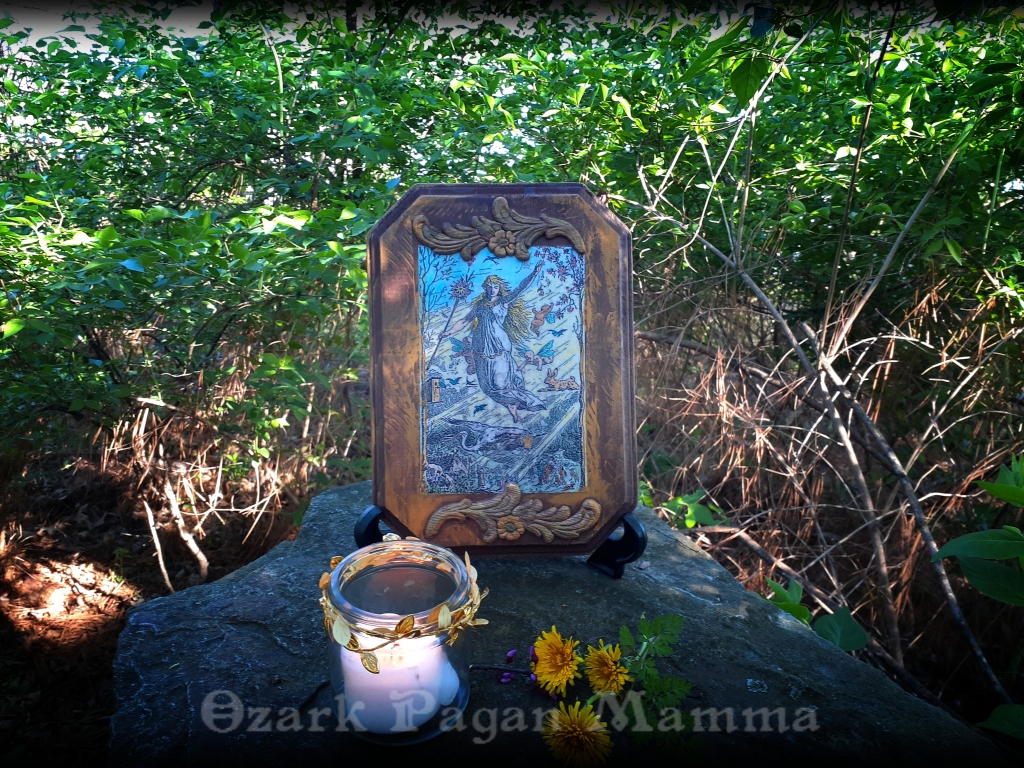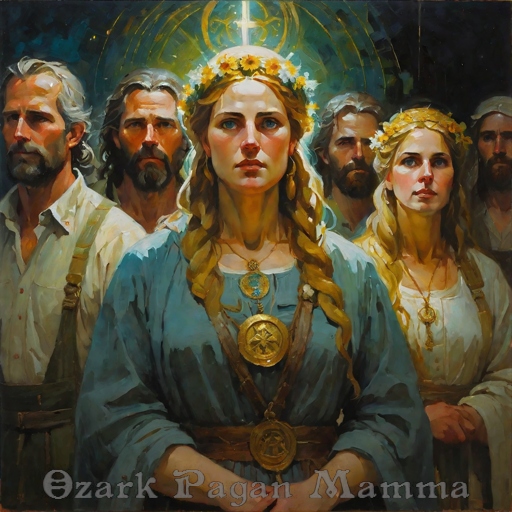In popular culture, we have this idea that the Norse pagans were the polar opposite of Christians, and it’s completely untrue. There are a lot of things in Christian practice that were very similar to earlier polytheistic practices across Europe. Yes, the pagans of old prayed and were even known to kneel in their worship. They had water purification traditions and even used a cross as one of their spiritual symbols. Christianity was not an alien tradition that dropped out of the sky, it grew out of older polytheistic traditions. It also changed, syncretized, and absorbed pagan traditions to convert or ease the conversion of more followers. So I have no problem in adapting Christian ideas for Heathen worship.
I had this idea to create a set of Heathen prayers that could be used with a “traditional” rosary. This type of rosary is really easy to find and is often even given away for free. One could change out the cross part for a tree pendant, but that is completely optional. The cross is an ancient symbol with many meanings. For these prayers, we use it to symbolize the World Tree. Starting at the cross/tree, we go through the rosary in the same order as one would for a traditional rosary.

Starting at the tree/cross, the first prayer is the “sign of the tree”.
Sign of the Tree
In the name of the Father,
the Mother, and the Tree of Life.
Blessed be.
Meditation:
The Tree of Life represents the connection of all life, the axis mundi powers upholding those connections, in whatever forms they take, in unity as well as multiplicity. We trace out the sign of the tree on our body- the Father and the mind/sky, Mother at the heart/earth, and the outward reaching branches of the Tree at our shoulders, to affirm the Holy Powers of the Tree of Life, the divine energy living in us, through us, and all around us.
The first large bead (as well as two more large beads later), we have this prayer:
The Allfather
Hail Wudan, Allfather, who traverses the worlds, exalted be your name.
As above, so below. That which has been will return again,
in concord with the great law of Nature.
Grant us this day your healing and wisdom, and aid us in our evolution.
And may our right actions be an offering to you, wherever we may wander.
So mote it be.
On the three beads after the first large bead, as well as the ten beads for the first decade (which has the theme of wisdom to meditate upon), we pray this one:
Hail Holda
Hail Holda, Shining Goddess, Font of Life.
Blessed are you, Mother of All, who guides us through every transition.
May our love and good works be an offering to you,
and may you comfort us always, until we return to your loving embrace
at the end of our days.
For the space between, that is, before going to the large bead that starts each new decade, we have this one:
Glory Be
Glory be to the Father, the Mother, and the Holy Powers of the Tree of Life.
As it was in the beginning, is now, and evermore shall be, unto the ages of ages.
So mote it be.
At this point, you could do these prayers for the whole rosary, ending with the centerpiece prayer, that I’ll get to last. However, I’ve included different prayers for each decade. These are the ones for the second decade, starting with a god prayer for the big bead, and ten goddess prayers on the small beads (and justice as the meditation):
The Skyfather
Hail Ziu, Skyfather and Lord of Justice, exalted be your name.
As above, so below. That which has been will return again,
in concord with the great law of Nature.
Grant us this day your balance and justice, and aid us in our evolution.
And may our just actions be an offering to you, in all our relations.
So mote it be.
Hail Zisa
Hail Zisa, Undoer of Knots, Mysterious Protectress.
Blessed are you, Lady of Justice, who clears the way.
May our love and fairness be an offering to you,
and may you protect us, this day and always.
Then another “Glory Be” and on to these prayers, in the same manner as above. For the third decade we have strength and sustenance for the meditation theme, and these prayers:
The Thunderer
Hail Dunnar, Strength of the Gods, exalted be your name.
As above, so below. That which has been will return again,
in concord with the great law of Nature.
Grant us this day your strength and protection, and empower us.
And may our courage be an offering to you,
as our hearts beat to the rhythm of your mighty hammer.
So mote it be.
Hail Siwwa
Hail Siwwa, Golden Goddess.
Blessed are you, strong and gentle sister, who gives to us our daily bread.
May our generosity with each other be an offering to you,
and may you nourish us, this day and always.
Then another “Glory Be” and on to these prayers, in the same manner as above. For the fourth decade we have peace and love for the meditation theme, and these prayers:
The Peacemaker
Hail Fro, Lord of Peace & Fertility, exalted be your name.
As above, so below. That which has been will return again,
in concord with the great law of Nature.
Grant us this day happiness and good fortune, and imbue us with your bliss.
And may our love and creativity be an offering to you, in all our relations.
So mote it be.
Hail Frīja
Hail Frīja, Beloved Lady.
Blessed are you, Shining Goddess, spinner of magic and love.
May our adoration and creativity be an offering to you,
and may you bless us with all the joys of life, this day and always.
Then another “Glory Be” and on to these prayers, in the same manner as above. For the fifth decade we have kinship for the meditation theme, and these prayers:
The Forefathers
Hail Ancient Forefathers, exalted be your names.
As above, so below. That which has been will return again,
in concord with the great law of Nature.
Grant us this day your wise counsel, and aid us in our evolution.
And may our love, remembrance, and good works be an offering to you.
So mote it be.
Hail Idisi
Hail Idisi, Clan Mothers.
Blessed are you, Shining Spirits, who guide and guard us
through all our trials and tribulations.
May our love, remembrance, and good works be an offering to you,
and may you comfort us always, until we join you in the Hall of the Ancestors.
Lastly, as we come around to the centerpiece, after saying one last “Glory Be” we have this prayer:
Hail Holy Queen
Hail, Holy Queen, Mother of All, hail, our life, our sweetness and our hope!
To you do we sing, far-flung children of Embla:
to you do we send our hopes, as well as our mourning.
Turn then, most gracious goddess, your loving gaze toward us,
and after our time in this world, show unto us the blessed realm of rejuvenation,
O merciful, O loving, O sweet Mother Holda! Blessed be.
So there we have it. You can follow along with the video I made for it, if you like. The repetition of the prayers is very meditative and comforting and also helps with memorization. You could also use the prayers on their own without prayer beads, of course, and adapt them as needed.













